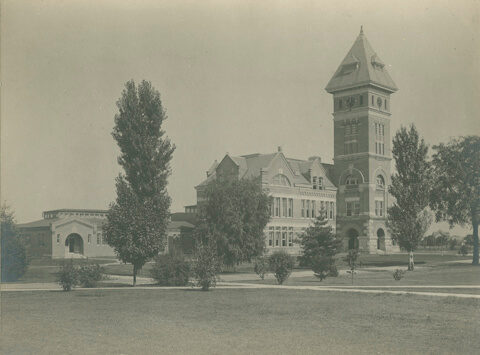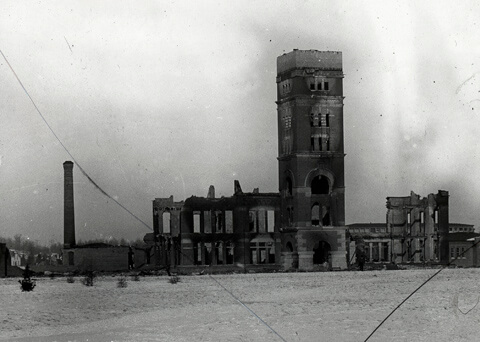Did You Know?: Heavilon Hall
February 12, 2015
 |
|
This photo shows Heavilon Hall in the early 1900s, after it was rebuilt following a fire that destroyed it in January 1894, just four days after it was initially built. The campus's resilience in the face of adversity gave rise to the often-used phrase, "one brick higher," which refers to President James Smart's fulfilled vow to rebuild Heavilon following the fire that destroyed it. (Photo courtesy of Purdue University Archives and Special Collections) |
Since 1894, Heavilon Hall on Purdue's West Lafayette campus has stood as a key academic building as well as an enduring symbol of the Purdue spirit.
In fact, Heavilon's storied history -- including a fire that destroyed it just after completion and the University president's subsequent vow to rebuild it -- gave rise to the phrase "one brick higher," now used across campus to embody Boilermakers' characteristic determination and dedication.
The building's story began in 1891, when the state legislature appropriated $120,000 as a deposit toward the construction of the first mechanical engineering building at Purdue.
In October 1892, President James H. Smart announced a significant gift: Amos Heavilon, a farmer and businessman from Frankfort, gave property, notes and cash worth $35,000 to Purdue, according to "A University of Tradition: The Spirit of Purdue," a book compiled by the Purdue Reamer Club. The legislature responded with another appropriation, and the building was completed and dedicated on Jan. 19, 1894.
 |
|
Heavilon Hall is shown in January 1894 following a fire that destroyed it. After the fire, which took place four days after the building was complete, Heavilon was immediately rebuilt. The new building was completed in December 1895. (Photo courtesy of Purdue University Archives and Special Collections) |
Just four days later, a boiler inside Heavilon Hall exploded. Fire ripped through the building, destroying it and most of its contents, including the groundbreaking Locomotive Testing Plant located near its center. Only the charred remnants of the building's tower remained standing, and it had to be demolished just a short time later, according to the Reamer Club book. The Purdue community was devastated.
The day after the fire, however, Smart stood before Purdue's faculty and students and proclaimed, "We are looking this morning to the future, not the past … I tell you, young men, that tower shall go up one brick higher."
Reconstruction began almost immediately. In the meantime, Smart told Purdue's seniors that the University's faculty would help them transfer to other universities if they wished to finish their coursework elsewhere while their classrooms were being rebuilt. Despite the offer, not one student left Purdue to pursue graduation at another institution, according to the Reamer Club book.
The rebuilt Heavilon Hall was completed in December 1895, and the first classes in it were held shortly after. Thanks to the generosity of Purdue's partner manufacturers, most of the engines and laboratory materials that were destroyed in the fire were replaced free of charge.
True to Smart's vow, the building's tower had been rebuilt higher than the original -- nine bricks higher, to be exact. The 140-foot-tall tower differed from its predecessor with the addition of a clock and four bells that chimed on the quarter-hour.
By 1956, weather and time had taken its toll on the building. In 1959, the current Heavilon Hall was built where the former one stood. Not part of the new building's design, the clock and bells in the old tower were placed in storage. Heavilon Hall now houses the Department of English and the Purdue University Writing Lab.
Heavilon Hall's clock and bells would not remain in storage forever, though.
In 2011, the restored clock was installed in the atrium of the Mechanical Engineering Building's Roger B. Gatewood Wing. The clock is in full working order with new bells and the original 9-foot pendulum.
Heavilon's original bells found a home in the Purdue Bell Tower, which was built in 1995. It is a 160-foot-tall, brick-clad, steel-frame modern interpretation of the original Heavilon Hall tower, according to the College of Liberal Arts -- and it is another reminder of the determination of a campus that met devastating adversity with a resilience that lives on to this day.
Writer: Amanda Hamon Kunz, 49-61325, ahamon@purdue.edu

